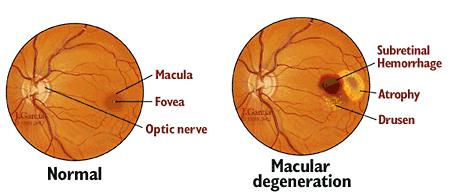AGE-RELATED MACULAR DEGENERATION
What You Need to Know
- Age-related macular degeneration (AMD) is a disease that affects a person’s central vision.
- AMD can result in severe loss of central vision, but people rarely go blind from it.
- Risk factors for AMD include being 50 and older, smoking, having high blood pressure and eating a diet high in saturated fat.
- Although there is no cure for AMD, there are treatment options that may prevent or slow the progression of the disease.
Age-Related Macular Degeneration Definition

AMD affects the central vision, and with it, the ability to see fine details. In AMD, a part of the retina called the macula is damaged. In advanced stages, people lose their ability to drive, to see faces, and to read smaller print. In its early stages, AMD may have no signs or symptoms, so people may not suspect they have it.
Types of Age-Related Macular Degeneration and Causes
The two primary types of age-related macular degeneration have different causes:
- Dry. This type is the most common. About 80% of those with AMD have the dry form. Its exact cause is unknown, although both genetic and environmental factors are thought to play a role. This happens as the light-sensitive cells in the macula slowly break down, generally one eye at a time. The loss of vision in this condition is usually slow and gradual. It is believed that the age-related damage of an important support membrane under the retina contributes to dry age-related macular degeneration.
- Wet. Though this type is less common, it usually leads to more severe vision loss in patients than dry AMD. It is the most common cause of severe loss of vision. Wet AMD happens when abnormal blood vessels start to grow beneath the retina. They leak fluid and blood — hence the name wet AMD — and can create a large blind spot in the center of the visual field.
Risk Factors for Age-Related Macular Degeneration
There are several risk factors that can contribute to developing age-related macular degeneration, including:
- Being 50 and older
- Eating a diet high in saturated fat
- Smoking
- High blood pressure or hypertension
Age-Related Macular Degeneration Symptoms
The following are the most common symptoms of age-related macular degeneration. However, each individual may experience symptoms differently. Symptoms may include:
- Blurry or fuzzy vision
- Difficulty recognizing familiar faces
- Straight lines appear wavy
- A dark, empty area or blind spot appears in the center of vision
- Loss of central vision, which is necessary for driving, reading, recognizing faces and performing close-up work
The presence of drusen, which are tiny yellow deposits in the retina, is one of the most common early signs of age-related macular degeneration. It may mean the eye is at risk for developing more severe age-related macular degeneration. These will be visible to your doctor during an eye exam.
The symptoms of age-related macular degeneration may look like other eye conditions. Speak with an eye care professional for diagnosis.
Age-Related Macular Degeneration Symptoms
In addition to a complete medical history and eye exam, your eye doctor may do the following tests to diagnose age-related macular degeneration:
- Visual acuity test. This common eye chart test measures vision ability at various distances.
- Pupil dilation. The pupil is widened with eyedrops to allow a close-up examination of the eye’s retina.
- Fluorescein angiography. Used to detect wet age-related macular degeneration, this diagnostic test involves a special dye injected into a vein in the arm. Pictures are then taken as the dye passes through the blood vessels in the retina, helping the doctor evaluate if the blood vessels are leaking and whether or not the leaking can be treated.
- Amsler grid. Used to detect wet age-related macular degeneration, this test uses a checkerboard like grid to determine if the straight lines in the pattern appear wavy or missing to the patient. Both indications may signal the possibility of age-related macular degeneration.

